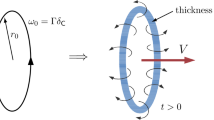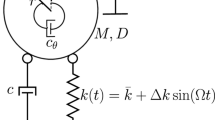Abstract
The flow behind a vibrating flexible cable at low Reynolds numbers can exhibit complex wake structures such as lace-like patterns, vortex dislocations and frequency cells. These structures have been observed in experiments and numerical simulations, and are predicted by a previously developed low-order coupled map lattice (CML). The discrete (in time and space) CML models consist of a series of diffusively coupled circle map oscillators along the cable span. Motivated by a desire to modify the complex wake patterns behind flexible vibrating cables we have studied the addition of control terms into the highly efficient CML models and explored the resulting dynamics. Proportional, adaptive proportional and discontinuous non-linear (DNL) control methods were used to derive the control laws. The first method employed occasional proportional feedback. The adaptive method used spatio-temporal feedback control. The DNL method used a discontinuous feedback linearization procedure, and the controller was designed for the resulting linearized system using eigenvalue assignment. These techniques were applied to a modeled vortex dislocation structure in the wake of a vibrating cable in uniform freestream flow. Parallel shedding patterns were achieved for a range of forcing frequency-forcing amplitude combinations studied to validate the control theory. The adaptive proportional and DNL methods were found to be more effective than the proportional control method due to the incorporation of a spatially varying feedback gain across the cylinder span. The DNL method was found to be the most efficient controller of the low-order CML model. The required control level across the cable span was correlated to the 1/1 lock-on behavior of the temporal circle map.
Similar content being viewed by others
References
P Bearman, Ann. Rev. Fluid Mech. 16, 195 (1984)
C H K Williamson, J. Fluid Mech. 328, 345 (1996)
M J Feigenbaum, L P Kandanoff and S J Shenker, Physica D5, 370 (1982)
S J Shenker, Physica D5, 405 (1982)
S Ostlund, D Rand, J Sethna and E Siggia, Physica D8, 303 (1983)
D J Olinger, Phys. Fluids A10, 1953 (1998)
O M Griffin and S E Ramberg, J. Fluid Mech. 66, 553 (1974)
D Yoerger, M Grosenbaugh, M Triantafyllou and J Burgess, J. Offshore Mech. Arctic Engg. 113, 117 (1991)
D J Newman and G E Karniadakis, J. Fluid Struct. 10, 439 (1996)
D J Newman and G E Karniadakis, J. Fluid Mech. 344, 95 (1997)
K Kaneko, Physica D37, 60 (1989)
K Kaneko, Physica D54, 5 (1991)
D J Olinger, A B Chhabra and K R Sreenivasan, Pramana — J. Phys. 48, 693 (1997)
L D Landau and E M Lifshitz, Fluid mechanics: Course in theoretical physics (Pergamon, Oxford, 1959)
J T Stuart, J. Fluid Mech. 9, 353 (1960)
K R Sreenivasan, P J Strykowski and D J Olinger, Hopf bifurcation Landau equation, and vortex shedding behind circular cylinders, in ASME forum on unsteady flow separation, FED 52, 1 (1987)
M Provensal, C Mathis and L Boyer, J. Fluid Mech. 182, 1 (1987)
J E Marsden and M McCracken, The Hopf bifurcation and its applications (Springer-Verlag, New York, 1976)
C H K Williamson, J. Fluid Mech. 206, 579 (1989)
M Hammache and M Gharib, J. Fluid Mech. 232, 567 (1991)
M P Davis, Low-order modeling of freely vibrating flexible cables (MS Thesis, Worcester Polytechnic Institute, Worcester, MA, USA, 2001)
E Ott, C Grebogi and J A Yorke, Phys. Rev. Lett. 64, 1196 (1990)
S Sinha and N Gupta, Phys. Rev. E58(5) (1998)
J Singer, Y Z Wang and H Bau, Phys. Rev. Lett. 66, 1123 (1991)
Y Wang, J Singer and H Bau, J. Fluid Mech. 237, 479 (1992)
P K Yuen and H Bau, Phys. Fluids 11, 135 (1999)
G Balasubramanian, Control of complex cylinder wake structures using coupled map lattices, MS Thesis, Worcester Polytechnic Institute, Worcester, MA, USA (1998)
W J Rugh, Linear system theory (Prentice-Hall, Englewood Cliffs, NJ, USA, 1995)
M Gad-el-Hak, Flow control: Passive, active and reactive flow management (Cambridge University Press, London, UK, 2000)
G C Goodwin and K S Sin, Adaptive filtering, prediction and control (Prentice-Hall, Englewood Cliffs, NJ, USA, 1984)
J C Sprott, Chaos data analyzer (Physics Academic Software, Raleigh, NC, USA, 1992)
Author information
Authors and Affiliations
Rights and permissions
About this article
Cite this article
Balasubramanian, G., Olinger, D. & Demetriou, M. Control of a coupled map lattice model for vortex shedding in the wake of a cylinder. Pramana - J Phys 59, 91–111 (2002). https://doi.org/10.1007/s12043-002-0035-2
Received:
Issue Date:
DOI: https://doi.org/10.1007/s12043-002-0035-2




